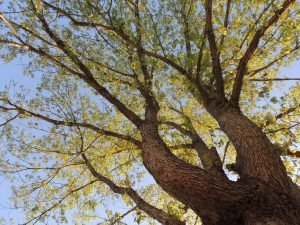Each semester I look around the circle of young writers gathered for one of my writing workshops, smile, and say, “So I have a little homework assignment for y’all.”
They always dutifully pick up their pens and start to open their notebooks, but I stop them, laughing, “You don’t need to write this down. I think you’ll remember.” I smile, lean forward, teasing them with a deliberate dramatic pause, and give them my favorite assignment ever. “I’m sending you to Dirt Church.”
“What? Where?”
Yep. Dirt Church.
A phrase my mama used to describe her time in the garden, I use it to remind my students how amazing they, the world, and beautiful writing actually are. When—and if–we take the time, the quiet to attend to them.
We, not only writers, all of us, have, I fear, become so disconnected from this beautiful mother planet, that it not only diminishes our writing, it diminishes, I think, the very quality of these meant-to-be-beautiful lives. And it absolutely affects those of us who strive so to reflect and record these amazing lives in literary form. I see it every workshop, in manuscript after manuscript with little to no sensory detail, no texture, and no setting.
I don’t blame the students. We live in a culture that moves us very early away from physicality, both our own and that which connects us to the planet. Don’t touch that-Put that down-Don’t play with your food-Don’t get dirty! echoes from childhood keep us inside, with our hands fearfully in our pockets and our toes tucked up tight inside shoes. We eat standing up or driving through, and resist the urge to touch luscious fabric in a department store, resist the urge to bury our faces in honeysuckle, resist the urge to curl our toes into velvety moss, think either we don’t have time or it’s childish to just lie back and watch the breeze play through dappled leaves.
We resist—have been trained away from—have lost touch with–the urge to do the very thing that makes living in these bodies so miraculous. Just BE.
So I assign Dirt Church. Minimally thirty minutes (must be at least thirty as it takes most of us at least fifteen to turn off the monkey mind) outside—just sitting. Sitting. Alone. Observing. Being. No phone. No yard work. No walking. No book to read. Just sitting.
My students, those cell-phone-toting-social-media-mavens, inevitably ask: What? What are we supposed to do?
Do nothing.
Be quiet.
Be present.
Be.
I suggest to them that they choose something specific to look at, like a tree, and share with them the amazing relationship I have with one majestic oak—we call it the Guardian Oak—that stands right outside my front door. I describe what she looks like in winter, soft silver and solemn, the texture of her bark as she sheds it, the numerous babies—squirrels, possum, woodpeckers, nuthatches—born in her branches over the years, the soft green and pink of her buds when they first appear, and how I wait for those buds, lying on my back beneath her each day, holding my breath, as I watch the buds unfurl into leaf.
If you can’t find a tree, then choose your time—dawn or twilight—so that you can watch the changing palette of the sky, the lavender horizon, the threading of clouds.
There’s always something to see. And this moment—this very moment—is the only moment we actually have guaranteed. Be in it.
The students usually give me the My-Teacher’s-a-Crazy-Hippie look, but that’s okay. I tell them to write about it—After! Not during!–a free-write in which the only thing required is that they include some description from all of their senses, and bring it back next class.
I assign it usually as a weekly assignment, as an exercise grade, or extra credit, giving them some structured reason to comply with my crazy-hippie-wishes, but what I see happen—in the free-writes and in our conversations—is that they fall in love again–with the natural world, with their own beautiful bodies and senses and the magic available through those senses. They remember—that childhood joy of hot sand and melting ice cream and salted tears. They begin to look forward to, even seek out, that island of blessed solitude in a crowded loud disconnected world that demands so much of them.
And they bring it to their writing, detailing and describing not only the dirt and trees and sky and feel of moss and taste of wind, but also the associations and relationships and reflection and quiet totally present listening, to themselves and to the world, that all good writers seek, that all good writing has,
and that all of us, frankly, as human beings need, writers or not.
Mary Carroll-Hackett
Director of Creative Writing
Longwood University
Follow us!Share this post with your friends.


Thank so much for including me! I am Associate Professor teaching Creative Writing at Longwood, programs for which I was the founder director, but I actually stepped down as coordinator in November 2011. Love Streetlight and am thrilled to be here!
Wonderful! And so true…Imagine, the world without
the media/machine “noise..”
elizabeth